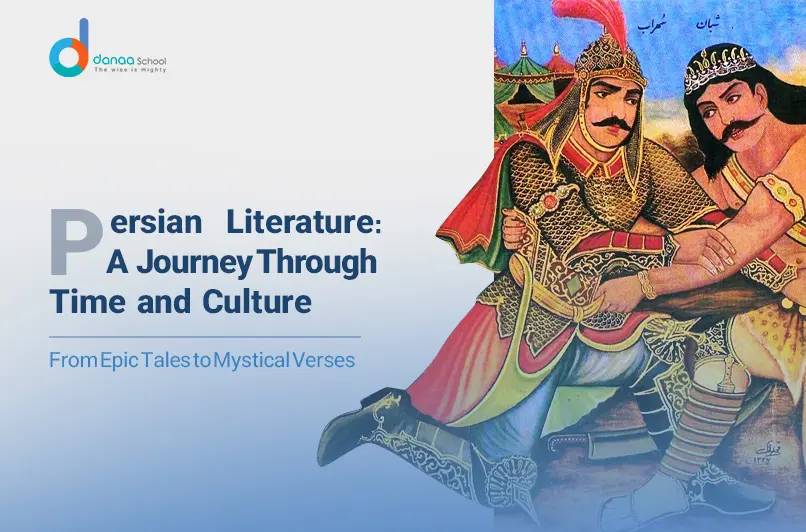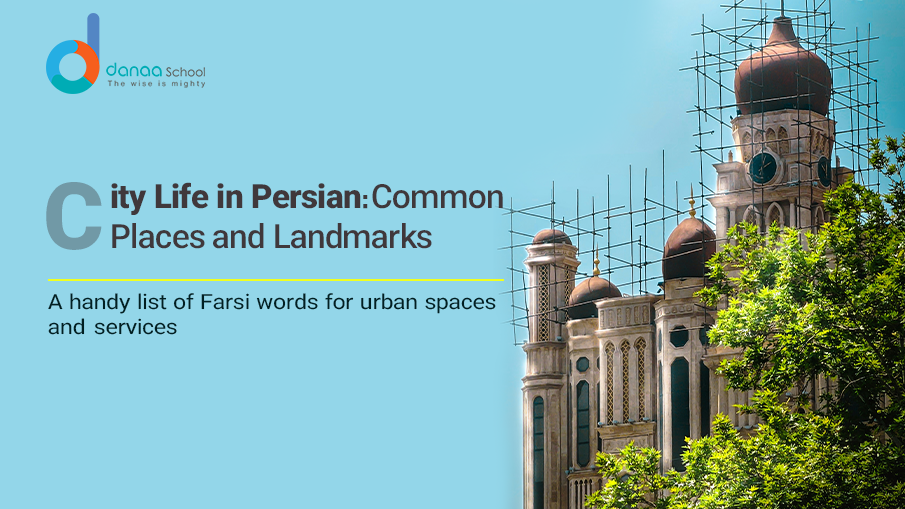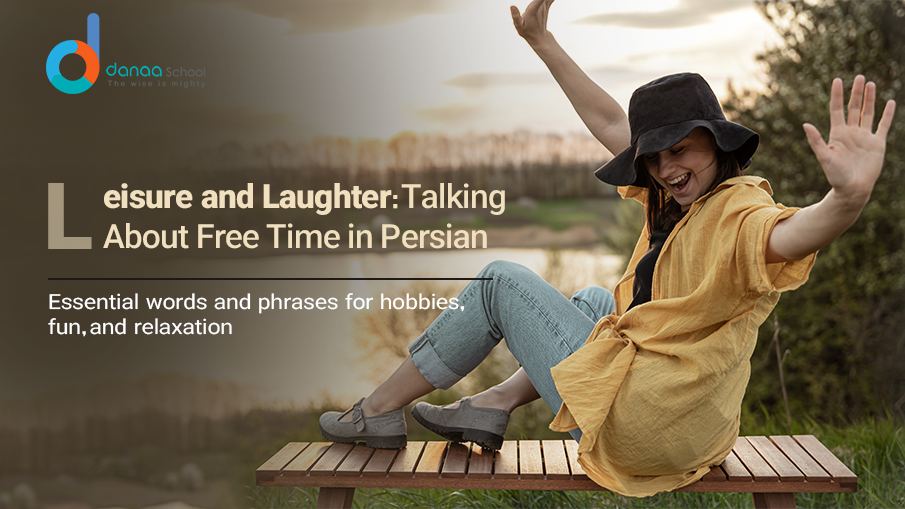What is Persian Literature known for?
Persian literature is one of humanity’s most majestic and profound cultural achievements, embodying a tradition that spans thousands of years and encompasses many emotional, philosophical, and aesthetic experiences. This comprehensive guide explores Persian literature’s historical roots, its rich thematic diversity, the luminaries who have shaped its course, and its undeniable influence on global culture.
Moreover, we delve into the vital role of institutions like Danaa School in preserving and disseminating this precious heritage today. Through this journey, readers will gain insights into the depth and breadth of Persian literary tradition, offering a panoramic view of its enduring legacy and relevance in the modern world.
Introduction to Persian Literature
The genesis of Persian literature can be traced back to the ancient Persian Empire, where it began as an oral tradition before being meticulously recorded in the Middle Persian language, known as Pahlavi. Over the centuries, it has evolved, mirroring the dynamic changes in the region’s political, social, and cultural landscapes.
Persian literature is not merely a collection of works written in the Persian language; it is a reflection of the soul of the Persian-speaking people, embodying their aspirations, reflections, and profound spiritual quests. This introduction sets the stage for an in-depth exploration of Persian literature’s historical evolution, key themes and genres, and the significant figures who have contributed to its rich tapestry.
The Epic Foundation: Ferdowsi’s Shahnameh
Ferdowsi’s Shahnameh, a colossal epic poem composed around 1000 AD, is more than just a literary masterpiece; it is the cultural bedrock of Persian identity. Through its tens of thousands of verses, the Shahnameh recounts the historical and mythical past of Iran, from the creation of the world to the Arab conquest of Persia in the 7th century.
This magnum opus not only preserved the Persian language at a time when Arabic was the dominant force in the region but also infused the Persian collective consciousness with a sense of unity and pride. The Shahnameh’s narratives of heroes, kings, and mythical creatures serve as allegorical reflections on morality, leadership, and the human condition, making it a perennial source of inspiration and identity for the Persian-speaking world.
The Shahnameh’s Role in Cultural Preservation
The significance of the Shahnameh in preserving Persian culture cannot be overstated. In a period marked by the erosion of Persian cultural and linguistic identity due to foreign domination, Ferdowsi’s work acted as a bulwark against cultural assimilation. By choosing to write in Persian at a time when Arabic was the lingua franca of science, philosophy, and literature, Ferdowsi ensured that the Persian language and its literary tradition would endure.
The Shahnameh is not just a repository of Iran’s ancient myths, legends, and history; it is a symbol of resilience and the enduring spirit of a people who, despite the vicissitudes of history, have clung to their cultural heritage with unwavering tenacity.
The Lyrical Beauty of Persian Poetry
Persian poetry is a universe offering an unparalleled richness of form, content, and emotional depth. The Persian poetic tradition encompasses a variety of forms, including but not limited to the ghazal (lyric poem), the qasida (ode), the masnavi (narrative poem), and the rubaiyat (quatrains). These forms have been vehicles for expressing a wide range of themes, from the ecstasy of divine love and the pain of separation to the joys and sorrows of earthly existence.
The beauty of Persian poetry lies in its ability to convey profound philosophical and mystical concepts through the delicate interplay of words, rhythm, and imagery, creating a transcendent experience that speaks to the heart and soul of the reader.
Sufism and the Quest for the Divine
The intertwining of Sufism with Persian poetry has produced some of the most sublime and spiritually profound works in the Persian literary canon. Sufi poets like Jalaluddin Rumi, Hafez, and Attar used poetry as a medium to express the ineffable experience of mystical love and the soul’s quest for union with the Divine.
Their works transcend religious dogma, offering a universal message of love, unity, and the pursuit of inner transformation. The appeal of Sufi poetry lies in its ability to articulate the deepest yearnings of the human heart, its quest for meaning, and the ecstasy of spiritual awakening, making it as relevant today as it was centuries ago.
Philosophical and Ethical Dimensions
Persian literature is celebrated for its aesthetic achievements and its profound engagement with philosophical and ethical questions. Throughout its history, Persian writers and thinkers have grappled with the nature of existence, the pursuit of wisdom, and the principles of ethics and morality. Works such as Saadi’s “Gulistan” and “Bostan” and Khayyam’s quatrains offer insights into the human condition, exploring themes of fate, free will, happiness, and the search for truth. These texts mirror the complex interplay between the spiritual and the temporal, the individual and the society, and the eternal quest for knowledge and virtue.
Saadi’s Gulistan and Bostan: A Blend of Morality and Wisdom
Saadi’s “Gulistan” and “Bostan” exemplify Persian literature’s ethical and philosophical depth. Combining prose and poetry, these works offer timeless wisdom through parables, anecdotes, and reflective passages. With his keen observation of human nature and society, Saadi addresses universal themes of justice, morality, humility, and the importance of compassion and human solidarity. His works are not just literary achievements but also practical guides for living a life of virtue and wisdom. The enduring popularity of Saadi’s “Gulistan” and “Bostan” across cultures and epochs attests to their universal appeal and their timeless wisdom.
The Global Influence of Persian Literature
The influence of Persian literature extends far beyond the borders of Iran and the Persian-speaking world. Through translations and cultural exchanges, Persian literature has left an indelible mark on world culture, influencing literary traditions, philosophical thought, and artistic expressions across Europe, Asia, and beyond.
Translating Persian works into Latin, English, and other European languages during the Renaissance and Enlightenment periods introduced Western audiences to the richness of Persian poetry and philosophy, inspiring poets, writers, and thinkers. The themes of love, mysticism, and existential inquiry in Persian literature resonate with universal human experiences, making their contributions to global culture significant and enduring.
Persian Literature and the West
The encounter between Persian literature and the West has been fruitful, leading to a rich cross-cultural dialogue that has enriched both traditions. The works of Rumi, Hafez, and other Persian poets have found a wide audience in the West, captivating readers with their depth of emotional and spiritual insight.
Scholars’ and poets’ translations and studies of Persian literature have played a pivotal role in this cultural exchange, bridging gaps in understanding and appreciation. This interaction has highlighted the universal themes shared by Persian and Western literary traditions and fostered a deeper appreciation for the diversity and richness of human cultural expressions.
Contemporary Perspectives on Persian Literature
In the contemporary world, Persian literature continues to thrive, adapting to the challenges and opportunities of the 21st century. The global diaspora of Persian-speaking people and the advent of digital technology have facilitated new forms of literary expression and dissemination. Today, Persian literature is a subject of academic study and a living tradition that continues to explore the complexities of modern life, identity, and cultural belonging.
Contemporary Persian writers and poets within Iran and in the diaspora are producing works that engage with the legacy of their literary heritage while addressing the pressing issues of our times.
The Role of Persian Literature in the Diaspora
For the Iranian diaspora, Persian literature is vital to their cultural heritage and identity. Literature becomes a means of preserving language, traditions, and collective memory in the context of migration and cultural displacement.
Diaspora writers and poets draw on the rich legacy of Persian literature to articulate their experiences of exile, identity, and belonging, creating works that resonate with their ancestral heritage and present realities. The diaspora plays a crucial role in keeping the Persian literary tradition vibrant and relevant for new generations through literary festivals, publications, and online platforms.
Why Danaa School?
Danaa School stands at the forefront of cultural education, offering a unique platform for exploring Persian literature among other global literary traditions. Recognizing the profound depth and breadth of Persian literature, Danaa School’s mission is to make this rich heritage accessible to a diverse audience. Through a carefully curated curriculum that includes online courses, workshops, and interactive learning Farsi experiences, Danaa School provides an engaging and comprehensive introduction to the world of Persian letters.
Bridging Cultures Through Literature
Danaa School is not just about learning; it’s about connecting cultures through the universal language of literature. By offering courses on Persian literature, Danaa School aims to bridge cultural divides, fostering a deeper understanding and appreciation of the Persian-speaking world’s contributions to global heritage. In an era marked by rapid globalization and cultural homogenization, Danaa School’s emphasis on literary education serves as a reminder of the importance of cultural diversity and the need to preserve and celebrate our shared human heritage.
FAQ
What Are the Main Literary Forms in Persian Literature?
Persian literature is characterized by diverse literary forms, each offering unique insights into the human experience. The epic narratives of the Shahnameh, the lyrical beauty of ghazals, the philosophical depth of masnavis, and the poignant simplicity of quatrains (rubaiyat) are just a few examples of the forms that have been developed and perfected over centuries. These forms have allowed Persian poets and writers to explore various themes, from the lofty realms of divine love and mysticism to the grounded realities of everyday life and social commentary.
How Can One Access Persian Literature Today?
With the advent of digital technology and the efforts of literary scholars and translators, Persian literature is more accessible today than ever before. A wealth of Persian literary works is available in translation, allowing readers worldwide to explore this rich tradition. Online platforms, digital libraries, and academic institutions provide valuable resources for those interested in delving into Persian poetry, prose, and philosophical texts.
How Does Persian Literature Reflect the Society and Culture of Its Time?
Persian literature serves as a mirror reflecting the Persian-speaking world’s societal values, cultural norms, and historical events through the ages. From the grand epic narratives of the Shahnameh, which immortalize the heroic ideals and moral virtues of ancient Persia, to the mystical poetry of the Sufi masters, which reveals the spiritual yearnings and philosophical inquiries of medieval Islamic Iran, Persian literature encapsulates the essence of its societal context.
What Role Do Women Play in Persian Literature?
Women have played a significant and evolving role in Persian literature as creators and subjects. In classical Persian literature, women are often idealized figures of beauty and love, serving as muses for poets to explore themes of desire and devotion. However, this traditional portrayal is just one facet of their presence in Persian literary tradition. Historical records and literary works evidence the contributions of female poets and writers, such as Rabia Balkhi, considered one of the first female Persian poets, and Mahsati Ganjavi, a 12th-century poet known for her rubaiyat.
How Has Persian Literature Adapted to the Digital Age?
Persian literature has shown remarkable adaptability to the digital age, embracing new platforms and technologies to reach wider audiences. The internet and digital publishing have revolutionized the way Persian literary works are disseminated and consumed, making them more accessible to readers worldwide. Websites, online libraries, and social media platforms now host vast collections of Persian poetry and prose, both classical and contemporary, facilitating interactions between authors, poets, and their global audience.
What Impact Has Translation Had on Persian Literature?
Translation has played a pivotal role in bringing Persian literature to a global audience, allowing its themes, aesthetics, and philosophical insights to transcend linguistic and cultural barriers. Translating Persian literary works into various languages has facilitated cross-cultural dialogues, introducing readers worldwide to the depth and richness of Persian poetry, prose, and philosophical texts.
Can Persian Literature Offer Insights into Today's Global Issues?
With its rich historical depth and thematic diversity, Persian literature offers timeless insights into many of today’s global issues, including themes of justice, morality, the search for meaning, and the human condition. The ethical quandaries, existential struggles, and aspirations for a better world that permeate Persian literature resonate deeply with contemporary concerns such as human rights, social justice, and the quest for peace and understanding across cultures.
Conclusion
So, what is Persian Literature known for? With its intricate tapestry of poetic expression, philosophical depth, and cultural reflection, Persian literature remains a vibrant and vital part of the world’s literary heritage. Through its exploration of universal themes of love, loss, joy, and the quest for meaning, it continues to speak to readers across time and space. Institutions like Danaa School are essential in preserving and promoting this rich tradition, offering pathways for exploration and understanding that bridge cultural divides and enrich our collective human experience.
With our expertly curated courses and resources, explore the poetic landscapes, philosophical inquiries, and cultural depths that define Persian literature. Discover the timeless wisdom and aesthetic beauty that have captivated readers and scholars for centuries. Enroll today and take the first step towards a deeper understanding and appreciation of one of the world’s most enduring literary heritages.









